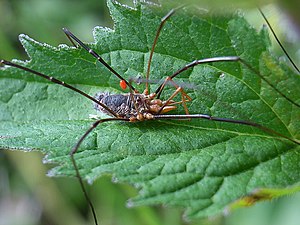Phalangium opilio
| Phalangium opilio | ||||||||||||
|---|---|---|---|---|---|---|---|---|---|---|---|---|

Phalangium opilio , male |
||||||||||||
| Systematics | ||||||||||||
|
||||||||||||
| Scientific name | ||||||||||||
| Phalangium opilio | ||||||||||||
| Linnaeus , 1761 |
Phalangium opilio is a harvester fromthe tailor family (Phalangiidae). It is one of the five species of the genus Phalangium occurring in Europe.
features
Males and females of this species differ significantly in their structure ( sexual dimorphism ). The smaller males are four to six millimeters long, the females reach a body length between five and seven millimeters. The chelicerae of the males are unusually developed. The scissors hand is pointed upwards. This extension is carried forward, the pliers themselves come to lie under the scissor handles. The male is easily recognizable through these forward-pointing tips, which can vary greatly in size.
The female lacks this extension of the scissor hand. It has a dark saddle spot on its back, which becomes even darker on the side and is bordered by a white stripe. The white stripe constricts the saddle spot twice. In the males, on the other hand, the saddle spot is not delimited on the side, but merges smoothly into the side.
Both sexes are very long-legged, the second pair of legs is the longest. Legs and rails are angular, the edges of the leg have thorns. The legs are mostly dark brown, on average a little gray in the females. The basic body color is variable, here too the females are a little grayer. The underside of the body is light beige to chalk white and without any markings.
Way of life
The eggs are clumped into packets and placed in cracks in the earth. This can be limited to a single lump of around 200 eggs, or a maximum of three egg packets are deposited with an interval of a few days to three weeks. The second and third egg packs only contain about 100 eggs. Young animals are mainly found in the litter, adults in the herb layer. Phalangium opilio can also survive down to −10 ° C for a period of up to two weeks. The animals predatory feed on arthropods .
distribution
The species is common almost everywhere in Central Europe. The animals can be found in open areas, on meadows and dry grass , in gardens and on roadsides. Sexually mature animals can be found from June to November.
swell
- Heiko Bellmann: Cosmos Atlas Arachnids of Europe. 2nd Edition. Franckh-Kosmos Verlags-GmbH & Co., Stuttgart 2001, ISBN 3-440-09071-X
.
